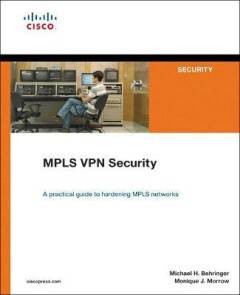
- Afhalen na 1 uur in een winkel met voorraad
- Gratis thuislevering in België vanaf € 30
- Ruim aanbod met 7 miljoen producten
- Afhalen na 1 uur in een winkel met voorraad
- Gratis thuislevering in België vanaf € 30
- Ruim aanbod met 7 miljoen producten
Zoeken
€ 72,95
+ 145 punten
Omschrijving
A practical guide to hardening MPLS networks
- Define zones of trust for your MPLS VPN environment
- Understand fundamental security principles and how MPLS VPNs work
- Build an MPLS VPN threat model that defines attack points, such as VPN separation, VPN spoofing, DoS against the network's backbone, misconfigurations, sniffing, and inside attack forms
- Identify VPN security requirements, including robustness against attacks, hiding of the core infrastructure, protection against spoofing, and ATM/Frame Relay security comparisons
- Interpret complex architectures such as extranet access with recommendations of Inter-AS, carrier-supporting carriers, Layer 2 security considerations, and multiple provider trust model issues
- Operate and maintain a secure MPLS core with industry best practices
- Integrate IPsec into your MPLS VPN for extra security in encryption and data origin verification
- Build VPNs by interconnecting Layer 2 networks with new available architectures such as virtual private wire service (VPWS) and virtual private LAN service (VPLS)
- Protect your core network from attack by considering Operations, Administration, and Management (OAM) and MPLS backbone security incidents
Specificaties
Betrokkenen
- Auteur(s):
- Uitgeverij:
Inhoud
- Aantal bladzijden:
- 286
- Taal:
- Engels
- Reeks:
Eigenschappen
- Productcode (EAN):
- 9781587051838
- Verschijningsdatum:
- 8/06/2005
- Uitvoering:
- Paperback
- Formaat:
- Trade paperback (VS)
- Afmetingen:
- 187 mm x 232 mm
- Gewicht:
- 557 g

Alleen bij Standaard Boekhandel
+ 145 punten op je klantenkaart van Standaard Boekhandel
Beoordelingen
We publiceren alleen reviews die voldoen aan de voorwaarden voor reviews. Bekijk onze voorwaarden voor reviews.











